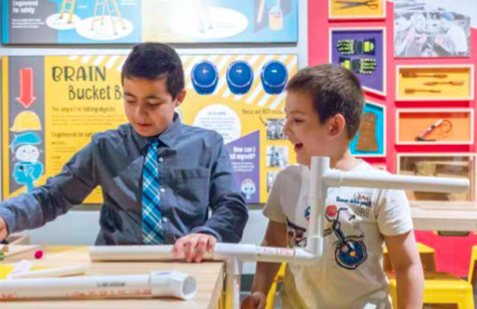This content has been archived as it may no longer be accurate or relevant.Gord Woodward, WorkSafeBC; November 2017
To commemorate WorkSafeBC’s 100-year anniversary, a unique partnership between Science World and WorkSafeBC is engaging kids in health and safety even before they start their first jobs.
Tinkering Space: The WorkSafeBC Gallery opened in October thanks to an innovative three-year partnership between WorkSafeBC and Science World. Aimed at children 7 to 18 years of age, the 900-square-foot (84 square metre) gallery uses interactive activities to educate them about health and safety.
“We’re investing in the children of today in recognition of their roles as the workers — and workplace leaders — of tomorrow,” says Al Johnson, WorkSafeBC’s vice-president, Prevention Services. “Through this partnership with Science World, we have a chance to connect directly with the workers of the future as part of our efforts to look ahead to our next 100 years of workplace health and safety.”
The gallery pairs WorkSafeBC’s expertise in health and safety with Science World’s understanding of education for young people.
“This is a perfect alignment of our missions,” says Andrea Durham, vice-president of Exhibits, Digital, and Evaluation at Science World. “Our exhibit is better because there were more creative people in the room. It was a great example of collaboration.”
Teaching safety through hands-on learning
The exhibits demonstrate actual workplace situations. Kids — and adults — can explore health and safety topics such as hearing, vision, and personal protective gear through a variety of hands-on activities such as soundproofing a buzzer, creating an even load on a vehicle, and making high-vis clothing. In the process they learn about engineering safety and the science behind health and safety.
“We want to connect kids to occupational health and safety concepts early,” says Johnson. “This
is an outstanding opportunity to build greater health-and-safety awareness among young people before they start looking for work.”
All stations in the Tinkering Space encourage hands-on creativity and problem-solving while emphasizing safe practices.
“Tinkering has become a movement. It lets people learn by doing,” says Durham. “Our exhibits stimulate them in the STEAM disciplines (Science, Tech, Engineering, Arts and design, and Math).”
A central area in the gallery provides the space for the kids — and adults — to tinker. There, kids learn to choose the appropriate tools for a job and how to use them safely. They can work on their own or join facilitated programming.
The science behind personal protective equipment
One exhibit vividly demonstrates the value of high-visibility clothing. It challenges users to spot people in a dark space with only ambient lighting. Then the lights come up, revealing the true number of people. A related tinkering workstation lets users try their hands at fashioning high-visibility clothing.
Another exhibit focuses on hearing protection. In a sound booth, users dial up a variety of sounds that they might be exposed to in a workplace. Options include voices and jackhammers.
With a new appreciation for the hazards of excessive noise, users can then tinker with sound-deadening protection using a decibel reader.
A third station focuses on head protection. By flipping a switch, users can drop objects on a dummy equipped with a series of different kinds of hard hats and helmets, and sensors. The resulting readings tell them how well the protective equipment did its job.
Safety in the next century
Tinkering Space: The WorkSafeBC Gallery is part of WorkSafeBC’s 100th anniversary celebration, and is the first exhibit of its kind for WorkSafeBC. The anniversary theme honours a century of progress in workplace health and safety while looking ahead to protecting workers over the next 100 years.
“Our goal here is to make health and safety relevant to young people,” Johnson says. “To have them learn the science behind safety and to connect it to their daily lives and futures.”
If they can do that even before they have paying jobs, young people can later enter the workforce with a health-and-safety mindset and expectation. They’ll be better able to recognize and reduce hazards and risks in the workplace. And they’ll be better prepared to stay safe on the job.
And down the road, that will help employers and workers achieve the goal they share with WorkSafeBC: a province free of work-related injury, illness, and death.
Click here to see the original article
Share this Post

